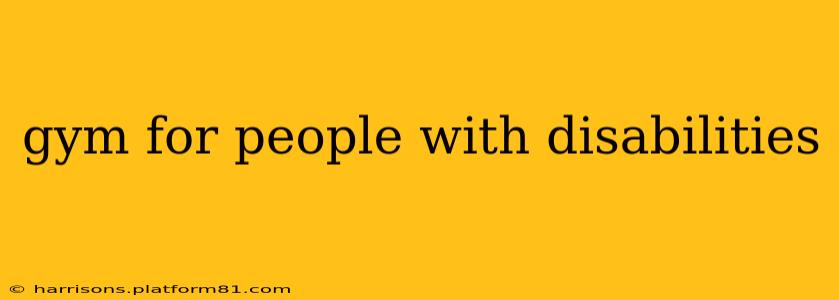Finding the right gym can be a challenge for anyone, but for individuals with disabilities, the search often requires extra diligence. This article will guide you through the process of locating an accessible gym that caters to diverse needs and abilities, ensuring a safe and empowering fitness journey. We'll cover everything from identifying key accessibility features to understanding the support systems available.
What Makes a Gym Accessible?
Accessibility extends beyond ramps and wider doorways. A truly accessible gym prioritizes inclusivity in every aspect, from equipment and facilities to staff training and programming. Key features to look for include:
- Ramps and Level Access: Easy entry and navigation without steps or significant inclines are crucial.
- Wider Doorways and Aisles: Ample space allows for wheelchair maneuvering and the use of assistive devices.
- Adaptive Equipment: This is paramount. Look for equipment modified for various needs, including adjustable weights, specialized seating, and equipment designed for seated exercises.
- Accessible Restrooms: Clean, spacious restrooms with grab bars and appropriate height fixtures are essential.
- Trained Staff: Staff members should be knowledgeable about adaptive exercises and comfortable assisting individuals with disabilities. Look for staff who've undergone relevant training.
- Inclusive Programming: The gym should offer classes and programs designed to accommodate different fitness levels and abilities.
- Emergency Procedures: Clearly defined emergency procedures and accessible emergency exits are vital for safety.
What Types of Adaptive Equipment Should I Look For?
Adaptive equipment makes all the difference in creating an inclusive workout experience. Some examples include:
- Adjustable benches and weight machines: These allow for various body positions and accommodate different mobility levels.
- Seated exercise equipment: Options for seated cycling, rowing, and upper body workouts are essential for users with mobility limitations.
- Resistance bands and light weights: These provide versatile workout options that are adaptable to different strength levels.
- Grab bars and support rails: Essential for stability and support during exercises.
Are there Specialized Gyms for People with Disabilities?
While not all gyms specialize exclusively in disability fitness, many are designed with accessibility as a core principle. Some gyms may offer specialized programs and equipment, making them particularly well-suited for individuals with specific needs. It’s always best to contact the gym directly to inquire about their specific accessibility features and services.
What Support Systems are Available at Accessible Gyms?
Beyond the physical features, the support system offered by the gym is vital. This includes:
- Personal Trainers with Disability Expertise: Finding a trainer experienced in working with individuals with disabilities ensures safe and effective workouts tailored to your specific needs.
- Group Fitness Classes for All Abilities: Look for gyms that offer modified classes or inclusive group exercise options.
- Community and Support Networks: Many accessible gyms foster a supportive community, helping individuals connect with others facing similar challenges.
How Can I Find an Accessible Gym Near Me?
- Online Search: Use search terms such as "accessible gym near me," "adaptive fitness center," or "disability-friendly gym."
- Disability Resource Organizations: Contact local disability organizations for recommendations and referrals.
- Community Centers and Recreation Departments: Many community centers offer accessible fitness facilities and programs.
- Word-of-Mouth: Connect with other individuals with disabilities to get personal recommendations.
Finding the right gym is a personal journey. Take your time, ask questions, and don't hesitate to visit several gyms before making a decision. Prioritizing accessibility ensures a safe, enjoyable, and empowering fitness experience for everyone. Remember, fitness is for everyone!
